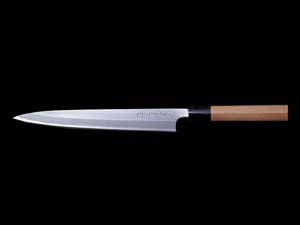Do Americans have bad taste? It’s a question we discussed here a few months back. Related, here’s a piece where Kenya Hara discusses Japanese aesthetics.
When coming back to Tokyo from abroad, my first impression usually is: What a dull airport! And yet it’s clean, neat and the floors deeply polished. To the Japanese eye, there’s a particular sense of beauty in the work of the cleaning staff. It’s in the craftman’s spirit — “shokunin kishitsu” — which applies to all Japanese professionals, be they street construction workers, electricians or cooks…
There is a similar craftman’s spirit (“shokunin kishitsu” or “shokunin katagi”) in Europe. Yet in Europe I can see it coming alive only from a certain level of sophistication. –In Japan, even ordinary jobs such as cleaning and cooking are filled with this craftman’s spirit. It is is common sense in Japan.
Hara also discusses why Japanese cooks prefer knives without any ergonomic shape.
A flat handle is not seen as raw or poorly crafted. On the contrary, its perfect plainness is meant to say, “You can use me whichever way suits your skills.” The Japanese knife adapts to the cook’s skill (not to the cook’s thumb). This is, in a nutshell, Japanese simplicity.

[thx Eva]

Jeremy at MicroExperience
on 22 Jan 10The idea that some cultures produce better, simpler designs is an interesting one. However, you can find examples of over-the-top complexity even in these supposedly design-oriented cultures. For example, the Japanese market favors mobile phones that are loaded with buttons and sliders and arcane options, and buyers there seem to have no interest in the iPhone—which people in most countries would regard as a brilliantly simple and elegant product.
While craftsmanship and attention-to-detail may be passed along more frequently within some cultures, it ultimately comes down to the interplay between vendors, designers, and consumers. When then intersection of these favors quality craftsmanship and simplicity, you get the sort of product that most designers would regard as well-designed. But if one or two of those factors trends towards lowest possible cost, tons of features, and so on, you end up with a very different (and probably not very elegant or well-crafted) product.
Jay Fanelli
on 22 Jan 10It’s interesting to note where America’s bread is buttered on the question of invention vs. design vs. craft. We’re heavy on invention and craftsmanship—at least historically—but relatively low when it comes to recognized design (or designers). We simply don’t have the culture of design that Europe or Japan enjoy, and really, never have.
Coincidentally, I just wrote a lengthy post about craft on my company’s blog.
grant talor
on 23 Jan 10really cool
Dutch
on 23 Jan 10@craftmanship: I recommend reading “shop class as soulcraft”.
it covers topics from Zen and the art of motor cycle maintenance, to outsourcing to agile principles of inspect and adapt.
Vesa M
on 23 Jan 10To comment the ergonomic shapes of knife handles: “western” ergonomic looking handles are rarely ergonomic. Their message is “I’m good in cutting stuff”. Many times those handles lie (in addition to be unergonomic).
Usually well chosen handle material and diameter contributes more to ergonomics than more complicated design. And this is not a rant about ergonomics. Along the subject: the simple handle is also about embodying (as in John Maeda’s Laws of simplicity, law 1). Simple handle (in well crafted knife) delivers more and than expected and the knife is more versatile in use. Instead of building for letdown .
Stuart Frisby
on 25 Jan 10The internet’s preoccupation with even the most inane nugget of Japanese culture is tiresome. The misconception that Japan is a country of perfectionists from the lowly street cleaner upwards is as ridiculous as any I’ve heard. For those of us who have dedicated significant portions of our academic and professional careers to the study of Japan (language, culture, history, etc.) it is frustrating to see over and over again the same old half-truthes being wheeled out and tenuously applied to anything and everything.
Japan is no more a perfect nation than any other, the mystique surrounding it; partly developed through the language barrier, and through the latent fanboyism which seems to have exploded in the last ten years present a country and a culture which in my considerable time spent living in Japan, and studying the culture, history and language of Japan, I just don’t see.
This week 職人気質, what next?
Tony
on 25 Jan 10So how do you explain Sony remotes having 1,000 buttons that are impossible to figure out?
Cup of Joe
on 25 Jan 10@Stuart – Dude, just relax.
This discussion is closed.